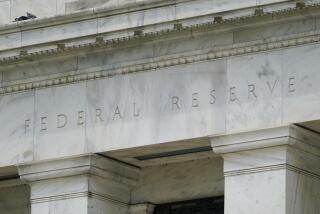Big Central Banks Swap Strategies : Coordinated Moves Are Designed to Sway Currency Rates
- Share via
FRANKFURT, West Germany — Four times a day the central banks of the leading capitalist countries hold a telephone conference to discuss their strategy for influencing foreign exchange rates.
Their success is varied in a currency market in which big corporations, investors, banks and speculators trade hundreds of billions of dollars daily.
Their main method is to intervene, buying or selling dollars or other currencies to steer values.
“Short of the outright lie, everything goes to fool the market,” a London market source said.
If the central banks enter the market cleverly, they can burn dealers and investors who might have thought, for instance, the dollar was a one-way bet.
Well-timed and concerted central bank sales can turn a hiccup in a trend into a speculative stampede in or out of a currency.
If they botch their business, they end up throwing national foreign exchange reserves into an insatiable market with nothing to show for it at the end of the day.
But the cry in a dealing room “the Bundesbank’s in” will still send dealers scrambling to telephones and screens.
The most important central banks are those of the biggest economies--the U.S. Federal Reserve, West Germany’s Bundesbank and the Bank of Japan.
They are joined in the telephone conferences by the Bank of England, the Swiss National Bank, and the central banks of the smaller European countries and Canada.
Bear Strategy
Central banks have long accepted that they cannot reverse a currency trend. For maximum impact, they try to catch the market on the turn.
For instance, dealers speculating on a weaker dollar, known as “dollar bears,” will sell more dollars than they have, to buy them back more cheaply when the dollar has fallen.
When this buying starts, the dollar will creep up. If the central banks buy heavily at that point they can push the dollar up so far that the speculators take a loss.
The speculators rush to cover their short positions in a frenzy of dollar buying, giving the dollar a momentum much greater than the central banks could achieve on their own.
Central banks pulled off such a coup in early 1988, just after the dollar hit a record low against the mark and yen.
“The bear squeeze mounted at the start of the year will be remembered as one of the bloodiest ever,” one London dealer said.
Tactics vary. For maximum publicity the central banks will place their orders through currency brokers. Word quickly spreads around the market that they are in.
If they want more discretion, they deal directly with banks. A dozen telephone calls simultaneously will cause prices to drop as the banks involved pass on the orders, but dealers in other centers will not know what is happening.
“All-in-all coordination on the currency market is very close,” said one West German central banker. “Nothing happens in intervention without the other central banks being informed.”
One Bought, One Sold
This does not always appear to be the case. Late in 1987, the Bundesbank was leading other central banks in buying dollars as the dollar tumbled to record lows.
At the same time Britain’s Treasury decided to diversify its foreign exchange reserves because of dollar weakness, and started selling dollars and buying marks.
Central banks may sometimes have less impact than they hope. One recent dollar drop looked like a reaction to Bundesbank sales. In fact, the market was reacting to a report that U.S. Commerce Secretary C. William Verity Jr. thought a lower dollar would be good for U.S. exports and the world economy.
More to Read
Sign up for Essential California
The most important California stories and recommendations in your inbox every morning.
You may occasionally receive promotional content from the Los Angeles Times.













